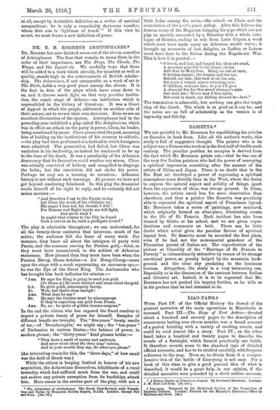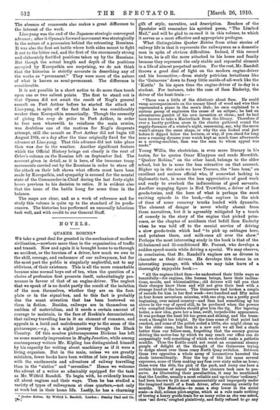IIAO-YANG:f
• Tke deka:items of Aristopbanes. The Greek Teas Revised, with Tranala- f Liao-yang. Prepared by the Historical Section of the Cemmittee of Son and Notes, by Benjamin Biekley Rogers. D.Litt. London: George Bell Imperial Defence. London: Printed for Ms Majesty's Stationery Office by Wrrn Part IV. of the Official History the thread of the general narrative of the main- operations in Manchuria is resumed. Part M.—The Siege of Port Arthur—devoted about a hundred and seventy pages to the description of occurrences lasting over eleven months, was a broad account of a period bristling with a variety of exciting events, and could be read almost like a story. Part W., on the other hand, takes a hundred and twenty pages to describe the events of a fortnight, which, formed practically one battle. It therefore reverts more to the atandard type of detailed official accounts, and has to be studied carefully, with frequent reference to the map. Even so, to obtain from it a compre- hensive idea of the battle of Liao-yang is not easy. For a book of this class to give a good general idea of what is described, it would be a great help, in our opinion, if the detailed narrative were preceded by a short outline account.
4. 4 Sinless Painter of Fronclacan Legend. By Bernhard Berernsin. London: J'. N. Dent and Sons. I_6s. net.]
The absence of comments also makes a great difference to the interest of the work.
Liao-yang was the end of the Japanese strategic convergent advance ; after it Oyama's forward movement was strategically in the nature of a procession behind the retreating Russians. It was also the first set battle where both sides meant to fight it out to the bitter end, and the first of the enormously strong and elaborately fortified positions taken up by the Russians. But though the actual length and depth of the positions occupied by Kuropatkin are surprising, we do not think that the historian is strictly accurate in describing any of the works as "permanent." They were more of the nature of what is known as semi-permanent. The difference is considerable.
It is not possible in a short notice to do more than touch upon one or two salient points. The first to stand oat is tbat Oyama did not await the result of Nogi's general assault on Port Arthur before he started the attack at Liao-yang, in spite of the fact that he was considerably weaker than Kuropatkin numerically. Though the necessity of giving the coup de grace to Port Arthur, in order to free men wherewith to reinforce the main armies, was doubtless one of the motives for Nogi's desperate attempt, still the assault on Port Arthur did not begin till August 19th, or a day after the time originally fixed for the advance at Liao-yang. That this advance did not take place then was due to the weather. Another significant feature which the Official History brings out clearly is the rout of Orlov's column on the Russian left on September 2nd. The account given in detail, as it is here, of the immense troop movements carried out by the Russians in order to stave off the attack on their left shows what efforts must have been made by Kuropatkin, and sympathy is aroused for the mental state of the Commander-in-Chief during the last forty-eight hours previous to his decision to retire. It is evident also that the issue of the battle hung for some time in the balance.
The maps are clear, and as a work of reference and for study this volume is quite up to the standard of its prede- cessors. The historian has performed an unusually laborious task well, and with credit to our General Staff.







































 Previous page
Previous page